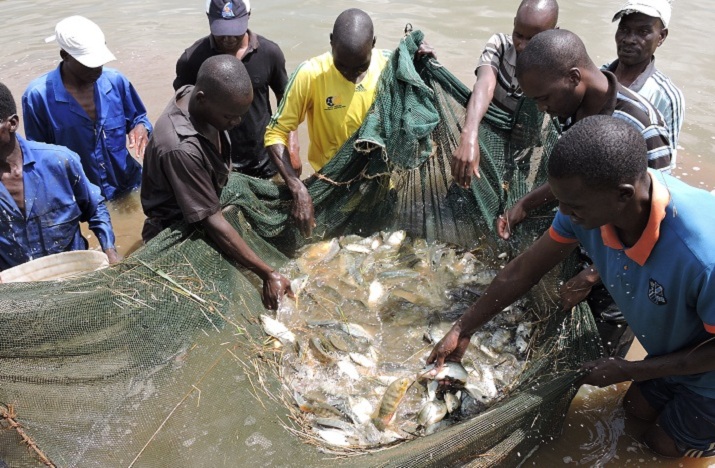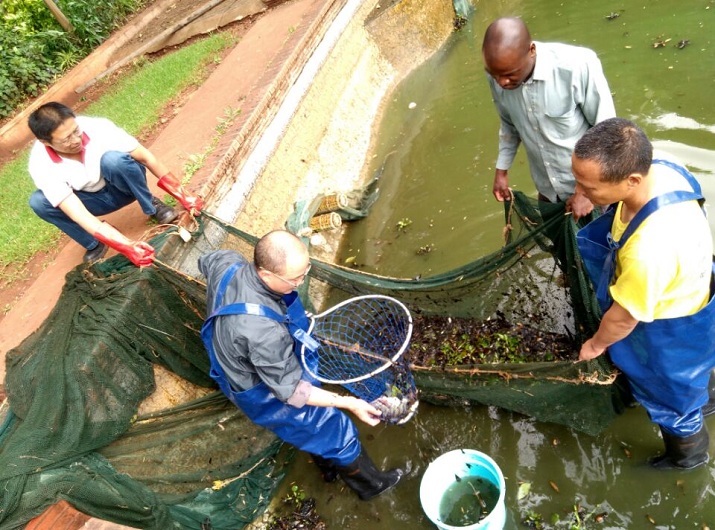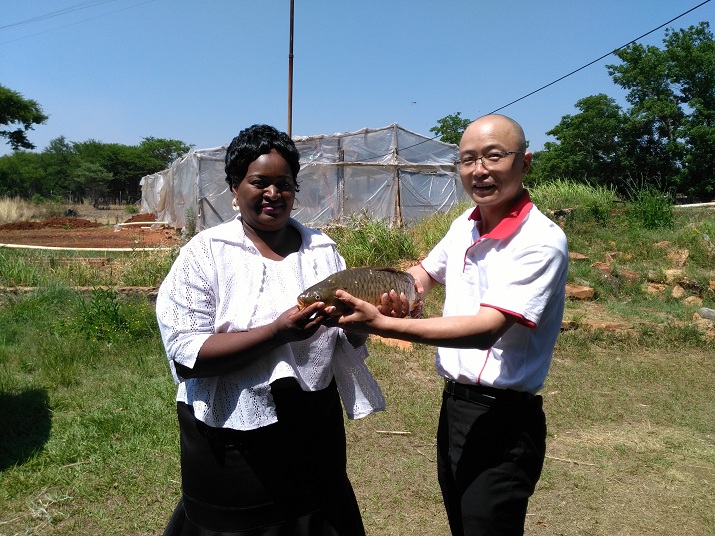|
||||||||||
| Home Nation World Business Opinion Lifestyle ChinAfrica Multimedia Columnists Documents Special Reports |
|
||||||||||
| Home Nation World Business Opinion Lifestyle ChinAfrica Multimedia Columnists Documents Special Reports |
| Africa |
| Fishing for Success |
| Innovative solutions unleash the full potential of Zimbabwe’s aquaculture |
| By Li Xiaoyu | VOL.9 November 2017 ·2017-11-08 |

Zimbabwean farmer Abel Gurupira used to think that aquaculture had nothing to do with cattle breeding. As a fact, at Milan Wood, his 15-hectare farm in Mashonaland West Province, fish, cattle and poultry used to be raised separately. But things changed after the visit of Pan Tingshuang, a Chinese aquaculture expert, in the region.
After visiting the farm in 2016, Pan approached Gurupira with a surprising idea: he could feed the small organisms living in the pond - such as plankton - with the fermented feces of his poultry and oxen. This would increase the number of primal organisms in the pond, giving fish an additional source of food - thus increasing productivity. Gurupira was excited at this innovative solution: "Fish do not eat excrement. But fermenting it to create a new source of food is a great idea. This creates a virtuous cycle."
Today, this rationalized system where aquaculture is integrated with cattle and poultry farming allows him not only to reduce his production costs, but also to take advantage of waste that would otherwise pose an environmental problem.
This is one of many examples of the change Pan brought to Zimbabwe after his arrival in November 2015 as a member of the fourth Chinese agricultural mission there, which was organized by Ministry of Agriculture of China. Throughout his two-year stint in the country, he said always stayed true to his initial mission: to unleash the great potential of Zimbabwe’s aquaculture.

Zimbabwean farmers learn aquaculture techniques
A large untapped potential
According to the latest report by the Food and Agriculture Organization (FAO) of the United Nations on the state of world fisheries and aquaculture, while China remains by far the biggest player in the global aquaculture industry, other countries are starting to follow suit.
In Nigeria, aquaculture production has grown 20 times in the last two decades and the whole of Sub-Saharan Africa seems to be following at the same pace. But despite abundant fish stocks, Zimbabwe’s aquaculture industry still lacks dynamism and contributes less than 10 percent to the national GDP.
In addition, fish provide only 2 percent of the total proteins consumed by Zimbabweans. As a result, the country must import each year nearly 40,000 tons of fish from South Africa or Mozambique to fill its deficit.
This situation only strengthened Pan’s determination to turn things around. "With the appropriate techniques, Zimbabwe’s aquaculture industry can be widely developed, which would allow access to a huge market. I am working to help local people improve their aquaculture techniques."

Aquacultural expert Pan Tingshuang sharing his skills
A field-based collaboration
With 20 years of experience under his belt, Pan designed adapted solutions for about 50 farmers like Gurupira, with whom he is still in contact.
One of their major concerns was how to better feed fish. After doing his research, Pan realized that there is only one fish food producer in the country and that a ton of fish food pellets can cost up to $1,500. With such high production costs, aquaculture farmers have to ration food pellets, which hampers their production.
To solve this problem, Pan suggested that the farms make their own food pellets with the help of the Chinese Government, which provided the necessary machinery.
"Even very simple tools can bring great help to us farmers [in Zimbabwe], because they help to lower production costs. This allows consumers to have access to cheaper fish," said Tim Viilnen, a local farmer.
Viable solutions
But fish food is far from being the only obstacle hampering Zimbabwe’s aquaculture sector. As his understanding of local conditions grew deeper, Pan realized that tilapia - the main fish species being raised in the country - was not fully adapted to local natural conditions.
Indeed, tilapia is a tropical fish species used to live in waters above 18 degrees Celsius. But in the central and southern parts of the country, temperatures can fall below 10 degrees Celsius in the winter, requiring the construction of greenhouses to cover the ponds, he explained.
"Why not simply try other species, more suited to local conditions? Carps, for example, have excellent resistance to cold weather and grow rapidly," said Pan.
Introduced in Zimbabwe in 1986, carps have thrived in the wild. For the first time, a trial artificial reproduction project is planned for the next year, with optimistic prospects for the future.
| About Us | Contact Us | Advertise with Us | Subscribe |
| Copyright Beijing Review All rights reserved 京ICP备08005356号-5 京公网安备110102005860号 |